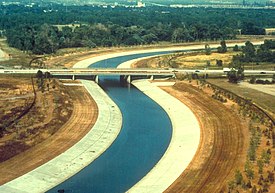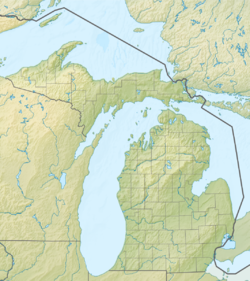
Back River Rouge (suba) CEB Rouge River German Rivière Rouge (Michigan) French Река Руж Macedonian 魯日河 (密歇根州) Chinese
| River Rouge Rivière Rouge | |
|---|---|
 Man-made falls on the River Rouge at Henry Ford's Fair Lane estate. | |
| Physical characteristics | |
| Source | |
| • location | Rochester Hills, Oakland County, Michigan |
| • coordinates | 42°37′56″N 83°10′35″W / 42.63225°N 83.17632°W[1] |
| Mouth | |
• location | Detroit River, Michigan |
• coordinates | 42°17′17″N 83°06′10″W / 42.28809°N 83.1027°W |
| Length | 127 mi (204 km) |
| Basin size | 467 sq mi (1,210 km2) |
| Discharge | |
| • location | mouth |
| • average | 378.16 cu ft/s (10.708 m3/s) (estimate)[2] |

The River Rouge is a 127-mile (204 kilometer)[3] river in the Metro Detroit area of southeastern Michigan. It flows into the Detroit River at Zug Island, which is the boundary between the cities of River Rouge and Detroit.
The river's roughly 467-square-mile (1,210 km2) watershed includes all or parts of 48 municipalities, with a total population of more than 1.35 million, and it drains a large portion of central and northwest Wayne County, as well as much of southern Oakland County and a small area in eastern Washtenaw County. Nearly the entire drainage basin is in urban and suburban areas, with areas of intensive residential and industrial development. Still, more than 50 miles (80 km) of the River Rouge flow through public lands, making it one of the most accessible rivers in the state.
Until recently the river was heavily polluted, and in 1969 oil on the surface caught fire.[4] The passage of the Clean Water Act in 1972 made it unlawful to discharge any pollution from a point source into navigable waters, and the EPA's National Pollution Discharge Elimination Program was created to regulate these discharges.
In 1986, a non-profit organization of concerned citizens called Friends of the Rouge was formed and began organizing an annual cleanup called Rouge Rescue, to raise awareness about the need to clean up the Rouge. In 1987, the entire watershed was designated a Great Lakes "area of concern" under the Great Lakes Water Quality Agreement.[5]
In 1992, a massive project called the Rouge River National Wet Weather Demonstration Project was implemented,[6] and further cleanup measures are ongoing. The Alliance of Rouge Communities is an organization of governmental and non-governmental entities created in 2006 to manage the watershed.[7]
- ^ "Rouge River". Geographic Names Information System. United States Geological Survey, United States Department of the Interior.
- ^ United States Environmental Protection Agency. "Watershed Report: River Rouge". watersgeo.epa.gov. Archived from the original on 2021-07-02. Retrieved 2021-07-02.
- ^ U.S. Geological Survey. National Hydrography Dataset high-resolution flowline data. The National Map, accessed November 7, 2011
- ^ Hugh McDiarmid, Jr. (July 2011). "When our rivers caught fire". Michigan Environmental Report. Michigan Environmental Council. Retrieved Nov 7, 2011.
In 1969 ... the oil-matted Rouge River in Detroit caught fire, shooting flames 50 feet in the air ...
- ^ "About River Rouge AOC". Archived from the original on June 25, 2018.
- ^ "Home | Environmental Services".
- ^ "History of the ARC". Alliance of Rouge Communities. Retrieved June 28, 2015.
